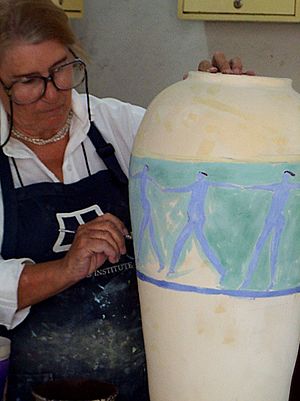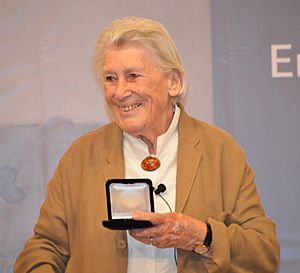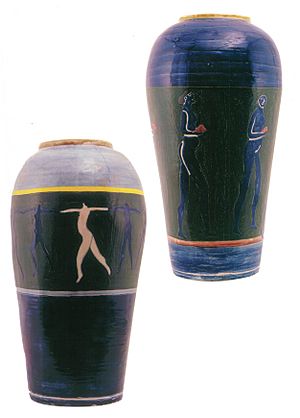Joy Laville facts for kids
Joy Laville (born September 8, 1923 – died April 13, 2018) was a talented artist. She was born in England but became known for her art in Mexico. Her journey as an artist began when she moved to Mexico to take art classes.
In Mexico, she met the famous Mexican writer Jorge Ibargüengoitia. They married in 1973. During this time, Joy mostly used soft pastel colors in her paintings.
Sadly, in 1983, Jorge Ibargüengoitia died in a plane crash. This event deeply changed Joy Laville's art. After his death, her paintings often explored themes of loss and eternity. Her artwork has been shown in many places, including the important Palacio de Bellas Artes and the Museo de Arte Moderno in Mexico. In 2012, she received the Bellas Artes Medal for her amazing work as an artist.
Contents
Joy Laville's Early Life

Joy Laville was born on September 8, 1923, in Ryde, a town on the Isle of Wight in England. Her father was a captain in the Indian Army. Her parents divorced when Joy was five years old. Her father passed away in 1939.
Joy described herself as a quiet and happy child. She loved being near the ocean. Her talent for drawing appeared early in her life. As a child, she enjoyed ballet and piano classes. She often drew pictures of ballerinas.
When World War II started, Joy had to leave school. She felt bored at home and asked for art classes. Her mother sent her to an art school in southern England. Because of the war, Joy joined the Observer Corps in Yorkshire. Her job was to track planes flying over England. The war made her realize how fragile life could be.
Moving to Canada and Mexico
At age 21, Joy married Kenneth Rowe and moved to Canada. She later said this marriage was a mistake. She lived in Canada from 1947 to 1956. Her husband worked as a logger in the forests of British Columbia. They lived in very remote places. Joy loved the vast forest but felt lonely. She read a lot to pass the time.
In 1951, her only son, Trevor, was born in Prince George, British Columbia. Joy worked as a secretary and took painting classes. She became unhappy with her marriage. When Trevor was five, she decided to leave Canada and her husband. She wanted a fresh start in Mexico.
Joy had heard that living in Mexico was affordable. She wrote to the Mexican consulate in Vancouver for advice. They suggested San Miguel de Allende as a good place to live and study art. She arrived in 1956, not knowing any Spanish. She rented a house and started taking art classes.
Joy lived in San Miguel de Allende for twelve years. From 1956 to 1958, she studied at the Instituto Allende. This was her only formal art training. After that, she tried different art styles like Cubism and Abstract Expressionism. Eventually, she found her own unique style. This is when art galleries started to notice her work. To support herself, she worked at the Institute in the mornings and painted the rest of the day.
Meeting Jorge Ibargüengoitia
After leaving the Instituto Allende, Joy worked in a bookstore. She met writer Jorge Ibargüengoitia in 1964. They started dating the next year. In 1968, Joy moved to Mexico City after her son went to college. She and Jorge lived together. They married on November 10, 1973.
Later, they decided to live in Europe. They spent time in London, Greece, and Spain. In 1980, they settled in Paris. Jorge often called Joy "la mujer lila," which means "the lily woman."
Sadly, Jorge Ibargüengoitia died in a plane crash in Spain in November 1983. Joy was at their home in Paris. She continued to live in Paris until 1985. She then returned to Mexico, feeling it was her true home. She moved near Cuernavaca, bringing Jorge's private library and his ashes with her. She later buried his ashes in front of his childhood home.
Joy Laville lived in the town of Jiutepec, near Cuernavaca. She continued to paint for several hours each day, even as she got older. Her house was filled with books and her paintings. She also had many photos of her son, Trevor, her granddaughter, Isabella, and her beloved husband, Jorge.
Her Art Career
After her studies, Joy Laville experimented to find her own art style. Her first art show in Mexico City was in 1964. Two years later, her work was shown at a big event at the Palacio de Bellas Artes. She won a prize there. This led to an invitation to exhibit her art at a famous gallery, the Galería de Arte Mexicano. She showed her work there regularly.
Jorge Ibargüengoitia encouraged Joy to keep a record of her paintings. He even photographed each one. He also helped her connect with Inés Amor, a very important gallery owner in Mexico City.
Joy's art has been shown in many cities around the world. These include New York, Paris, London, and Barcelona. She had major exhibitions at the Palacio de Bellas Artes in 1966, 1968, and 1985. She also had shows at the Museo de Arte Moderno in 1974 and 2004. The 2004 exhibit was a large show of 94 of her artworks.
Her paintings have even appeared on the covers of books written by her husband. Joy Laville has received several awards for her art. In 1966, she won a prize from the Palacio de Bellas Artes. In 2012, she was given the Bellas Artes Medal for her lifetime of artistic work.
Joy Laville's Artistic Style
Joy Laville is best known for her paintings, using oils and acrylics. But she also created other types of art. These include prints, pastels, and sculptures. One of her bronze sculptures was placed on a famous street in Mexico City in 2000.
Joy Laville has been seen as part of a group of artists in Mexico called the "Generación de la Ruptura." This group challenged older art styles. However, Joy always said she didn't belong to any specific art movement. She simply painted in her own way. She considered herself a Mexican painter because she started her art career there.
She said that artist Roger von Gunten was a very important influence on her work. She also admired artists like Lilia Carrillo and Francisco Corzas. Her art shows influences from famous painters like Henri Matisse and David Hockney. Her work has been compared to Milton Avery because both artists used large, simple spaces and soft colors.
Joy Laville's art has two main periods. These are divided by the death of her husband in 1983.
Before her husband's death, her art often showed everyday life. She painted self-portraits and landscapes. In the 1960s, she used darker colors. But in the 1970s, she started using more pastels, like blues, pinks, and light purples. Her self-portraits changed too. Before her marriage, she painted herself as small and shy. But during her marriage, her image of herself became larger and more confident. Jorge Ibargüengoitia described her paintings as "a window into a mysteriously familiar world."
After Jorge's death in November 1983, Joy stopped painting completely for a few months. When she started again, her art became like a diary of her grief. Her paintings showed pain, anger, and sadness. The colors became sharper. Cracks in walls often appeared in her art, symbolizing frustration. Her first paintings after this time showed a woman with one eye and a falling airplane in the background. This referred to the plane crash.
Over time, her grief began to turn into acceptance. Her later paintings explored what happens after death. Works like "Man Jumping Off a Rock" (1986) and "Man Leaving a Boat" (1986) show this change. The sea and the horizon became symbols of death, but the images were peaceful. She used blues, greens, and whites to represent water and peace. Her paintings often show small figures in vast spaces. The horizon in her art often symbolizes another world or the limit of what we know. Her paintings bring feelings of calm and comfort, but also solitude.
See also
 In Spanish: Joy Laville para niños
In Spanish: Joy Laville para niños



